As you get older, it’s not unusual to experience finger pain, arthritis, or swelling in the joints. Other conditions, such as tenosynovitis or tendonitis, can affect anyone who engages in frequent and repetitive movements of the muscles of their hands. Repetitive hand movements, such as typing on the computer or using a smartphone, increase friction between the tendons of the fingers, causing the tendons to swell and the sheath around the tendon to thicken. In more extreme cases, you may experience “trigger finger,” a condition that causes the finger to lock into a bent position or pop like a spring when you try to stretch it out.
Tendonitis is the inflammation of a tendon, while tenosynovitis is a related condition that includes inflammation in the sheath around the tendon. The conditions frequently occur together, causing tightness and aching in the muscles and tissues. The inflamed area becomes tender to touch, and you’ll often feel burning pain when gripping or holding objects. Acupuncture for hand tendonitis may provide some much-needed pain relief in the fingers and thumbs and improve the quality of life for those suffering from this painful condition.
How Long Does Hand Tendonitis Take To Heal?
You can treat mild tendonitis by yourself at home. In the acute phase, icing the hand can reduce inflammation, and using tape or a splint to immobilize the tendon will allow it to rest. Except for the most severe and chronic conditions, avoid injections of anti-inflammatory agents such as painkillers and steroids, as these can lead to scarring of the tendons and muscle tissue.
Once the acute phase is over, you’ll want to use hand exercises to stretch the tendon sheath and improve flexibility in the tendon. Hold one hand out flat and bend your fingers and thumb in the opposite direction to the natural bend, pushing or pulling them gently with the opposite hand. Open your hand, spreading the fingers as wide as possible. Try stretching the fingers one by one against their natural direction. If you repeat this throughout the day, especially while taking a hot bath, your fingers will begin to move more easily, and the swelling should begin to go down.
If you continue with daily hand exercises, you should quickly feel reduced pain in the mornings. Symptoms often improve in as little as two weeks, and even in the worst cases, two months is usually long enough to recover. At the same time, using acupressure or acupuncture for hand tendonitis can provide effective pain relief and promote blood circulation, bringing healing nutrients to the affected area and speeding up your recovery.
Does Acupuncture Work On The Hands?

Acupuncture is effective in treating many types of tendonitis. Although ice and splints can prevent injury in the short term, keeping the affected area cold and immobile decreases blood flow and allows the muscles and tendons to atrophy, delaying recovery. Acupuncture for finger tendonitis, on the other hand, relieves stiffness and tension in the joints and increases the flow of blood, promoting a cascade of healing processes. Improved blood circulation delivers oxygen and healing nutrients to the injury, and the body is able to fight the inflammation more effectively.
Acupuncture for hand tendonitis is especially effective in treating chronic pain in the fingers and thumbs. By opening the meridian points and promoting the flow of vital energy in the body, the needles relieve tension and pain in the nerves and joints. A systematic review of ten clinical studies published in 2022 found acupuncture for hand tendonitis effective in short-term pain reduction and functional improvement in both hand and wrist conditions. The review also noted the safety of acupuncture treatment, with none of the adverse effects of other interventions such as steroid injections.
Clinical studies have also shown that acupuncture may be an effective treatment for trigger finger. In a case series published in Acupuncture in Medicine, acupuncture was performed up to five times daily on fifteen patients, each of whom was asked to evaluate pain and severity during snapping using a visual analogue scale (VAS). Not only did many patients report an improvement in pain scores, but also a shortened duration of the disorder, leading the researchers to postulate that acupuncture may reduce inflammation in the synovial membrane of the tendon sheath.
What Are The Acupuncture Points For Tendonitis In The Hand?
Acupoint: TE-4 (Other Names: Triple Energizer-4/Yang Chi/Yang Pool)
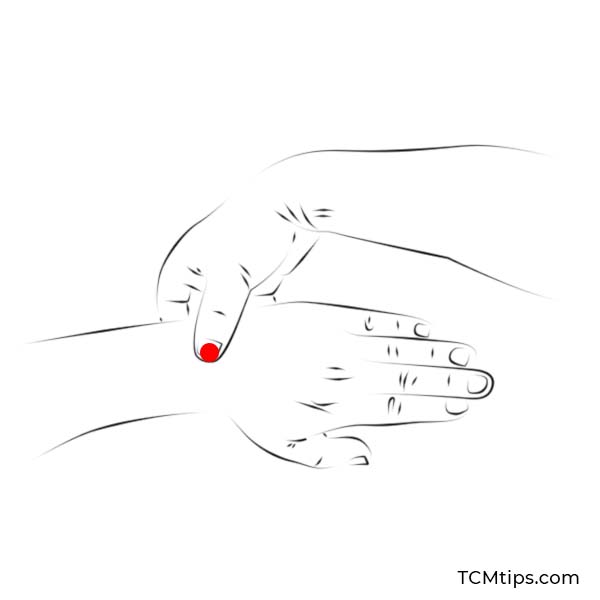
Activating the Yang Pool promotes heat and blood circulation throughout the body, providing relief from cold and stiffness in the joints. TE-4 is a useful point for treating pains and strains in the hand and the wrist and is often employed in acupressure for carpal tunnel syndrome.
TE-4 is located on the back of the arm, in the wrinkles that appear when you flex the wrist. This is where the bones of the ring and middle fingers end. One good method of stimulation is to press the Yang Pool with the point of a pen or pencil (without the nib) or the fingernail of the thumb. You should press with enough force to feel a little pain for about ten seconds each time.
Although TE-4 is counted among the best acupressure points on the hand for shoulder pain, other acupoints on the Triple Energizer meridian, such as TE-14 and TE-15, are more commonly employed in acupuncture for shoulder tendonitis.
Acupoint: TE-5 (Other Names: Triple Energizer-5/Wai Guan/Outer Pass)
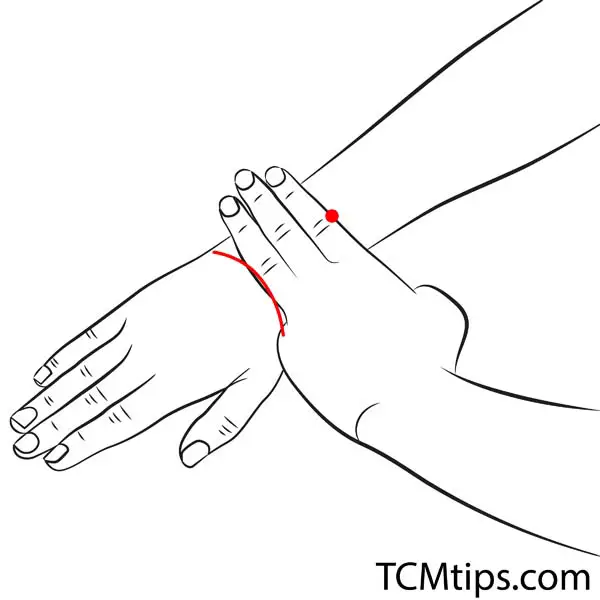
The second of our pressure points on the forearm used to treat pains in the hand, and the wrist is the Wai Guan or Outer Pass. TE-5 is especially effective in treating the pain caused by rheumatism and arthritis, making it an essential point for acupuncture for hand tendonitis.
Stimulation of TE-5 calms the autonomic nervous system and provides relief from pain in the fingers, hand tremors, and wrist pain. This versatile acupoint is also used to treat headaches, fatigue, and abdominal pain, as well as being among the best acupressure points for back pain.
TE-5 is located on the outer side of the forearm, three finger-widths above the wrist crease, between the radius and the ulna bones. The nerves here control the fingers, and stimulation helps to improve hand movements. If you want to perform acupressure for hand tendonitis at home, apply firm pressure on the Wai Guan with the tip of your thumb or the end of a ballpoint pen.
Acupoint: HT-1 (Other Names: Heart-1/Ji Quan/Highest Spring)
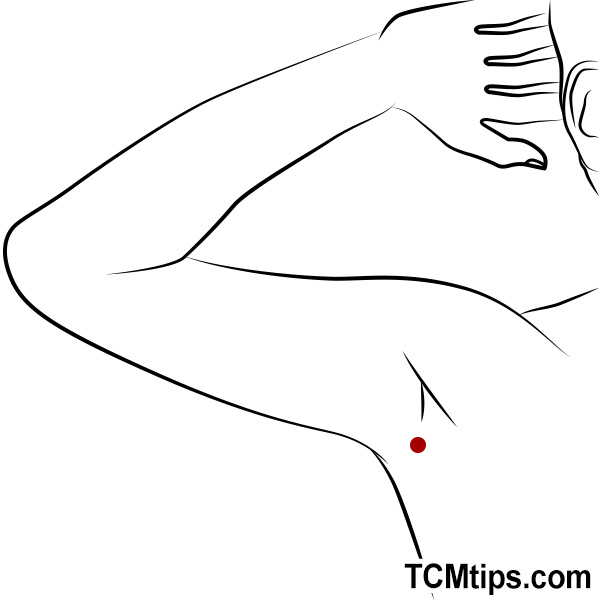
Although the Ji Quan, or Highest Spring, is one of the heart meridian points, it is located on the arm. More precisely, it’s found in the center of the armpit.
Stimulation here promotes the flow of blood and meridian energy through the shoulders, the arms, and the hands.
Acupoint: LI-5 (Other Names: Large Intestine-5/Yang Xi/Yang Stream)
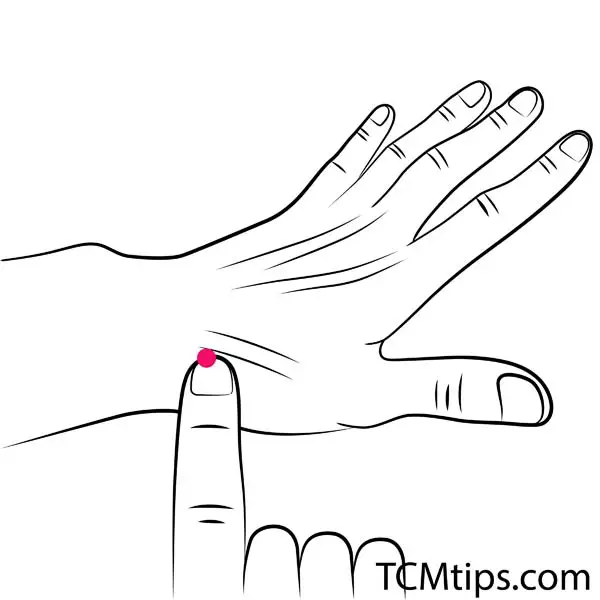
Among the most important thumb tendonitis acupuncture points is the Yang Xi, located where the base of the thumb meets the wrist. Stimulation here has a strong analgesic effect, relieving discomfort in the wrist, the hand, and the fingers, making LI-5 an essential point in acupuncture for hand pain.
This acupuncture point is in a sensitive part of the hand, between the tendons. If you want to use acupressure for hand tendonitis at home, apply gentle pressure here, rubbing in small circles.
Acupoint: LU-7 (Other Names: Lung-7/Lie Que/Broken Sequence)
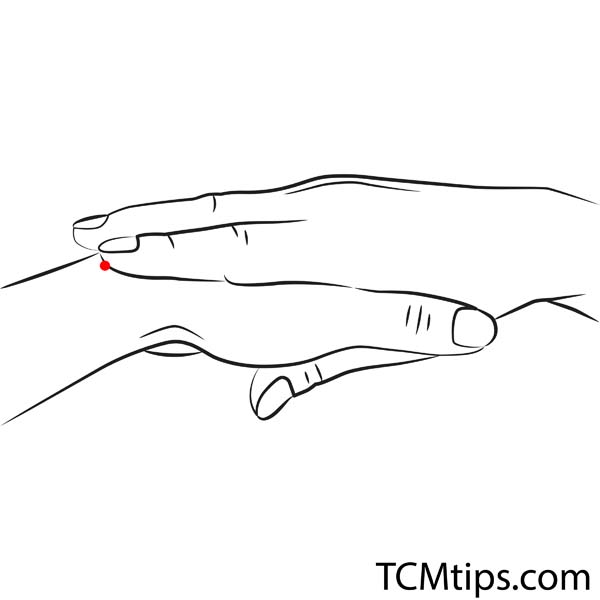
Activation of the Lie Que opens up the lungs and makes it easier to breathe, making LU-7 one of the best acupressure points for asthma. Stimulation of the LU-7 relieves symptoms of cough and sore throat, as well as headaches brought on by external pathogens.
Although it belongs to the lung meridian, LU-7 is located close to the wrist. You can find it by interlocking the thumb and index finger with one hand with those of the opposite hand. Now, look for the Lie Que in the depression between the sinew and the bone, along the edge of where the index finger rests.
Massaging the LU-7 helps to relieve pain in the thumb, index finger, or middle finger, and reduce swelling or inflammation in the hand, making it another useful point in acupuncture for hand tendonitis.
Acupoint: SI-6 (Other Names: Small Intestine-6/Yang Lao/Support the Aged)
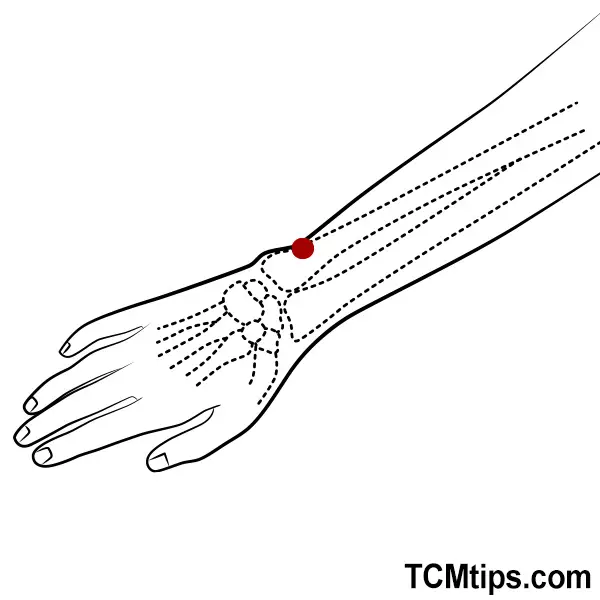
Although it belongs to the small intestine meridian, the SI-6 acupoint is effective in treating pain in the ring and little finger and is also used in acupressure for ulnar nerve pain. Stimulation here helps relieve feelings of numbness or paralysis in the hands, as well as having an analgesic effect on the back, the shoulders, and the arms.
To locate SI-6, look for the bone that protrudes from the top of your wrist when you hold your palm facing downwards. The Yang Lao, as it is known in Traditional Chinese Medicine (TCM), is found directly below that bone.
Acupoint: SI-7(Small Intestine-7/Zhi Zheng/Branch of the Upright)
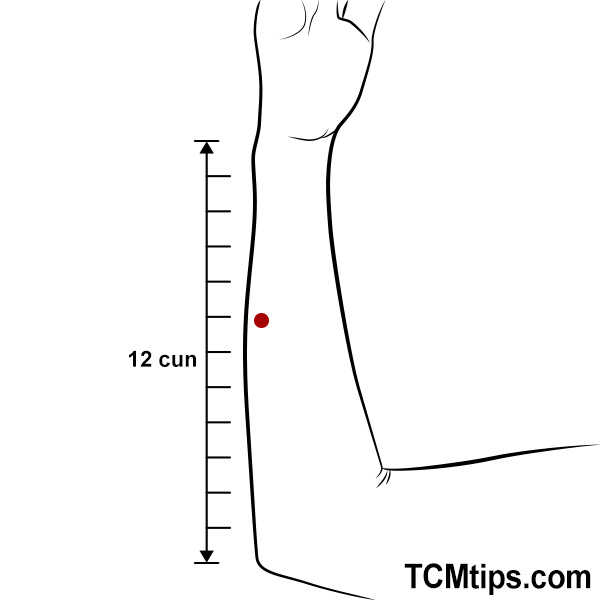

According to Traditional Chinese Medicine (TCM), activating the Zhi Zheng clears heat from the body and calms the Shen, making it useful both in calming anxiety or manic behavior and preventing the onset of conditions such as colds or flu.
SI-7 is located further up the forearm from SI-6, between the medial edge of the ulna bone and the carpi ulnaris muscle. Stimulation here strengthens the joints of the arm and the hand.
If you have pain in the fingers, try stimulating the tender points that run along the meridian between SI-6 and SI-7.

Try our Anti-Aging Gua Sha Tool designed to bring out your skin’s natural glow.
Best Gua Sha Product- Anti-Aging: The tool is designed to target 11 specific aging signs such as wrinkles and sagging skin. By following the 7-step routine, users can improve skin firmness and reduce fine lines naturally.
- Enhances Skincare Routine: It works effectively with serums and lotions, boosting absorption and efficacy of skincare products.
- Visible Skin Improvement: Users can expect a smoother complexion, reduced puffiness, and a more youthful appearance.
 P. Sze
P. Sze 

















